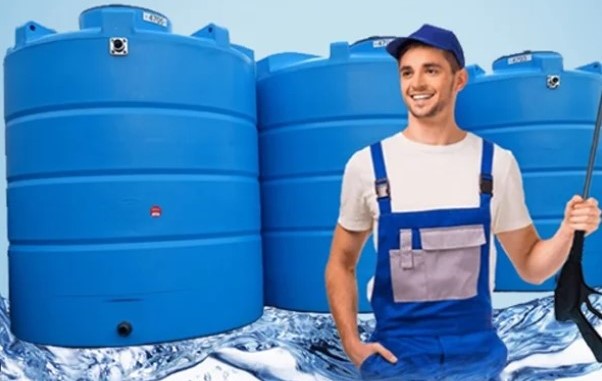Water tank Cleaning

Water tank cleaning is a thorough process to remove sludge, algae, silt, bacteria, and other contaminants from overhead or underground water storage tanks. This ensures clean, odor-free, and safe water for household, commercial, or industrial use.
🏠 Where Water Tank Cleaning Is Needed
• Residential apartments and villas
• Commercial buildings & offices
• Schools, colleges & hostels
• Hospitals & clinics
• Hotels, restaurants, and factories
🔹 Types of Water Tanks Covered
Tank Type Location Material
Overhead tanks Terrace Plastic (HDPE), concrete, or stainless steel
Underground tanks Basement/ground RCC (concrete), plastic
Sintex/Poly tanks Above/Below HDPE or polymer
Stainless steel tanks Indoors/Outdoors SS304/SS316
🔹 Standard 6-Step Water Tank Cleaning Process
1. Initial Inspection & Drainage
• Inspect tank for cracks, smell, or algae growth
• Drain all water using a submersible pump
• Remove solid sediments at the bottom
2. Manual Scrubbing
• Inner walls, ceilings, and floors are scrubbed using brushes or scrubbers
• Removes sludge, algae, biofilm, and mineral scaling
3. High-Pressure Water Jet Cleaning
• Use of jet sprayers to flush off loosened dirt
• Targets hard-to-reach corners and wall joints
• Ensures complete removal of physical contaminants
4. Vacuum Sludge Removal
• Industrial-grade wet vacuum used to remove sludge, silt, and residue
• Prevents recontamination of surfaces
5. Anti-Bacterial Disinfection
• Spray or rinse tank with non-toxic, food-grade disinfectant (e.g., hydrogen peroxide, chlorine solution)
• Ensures elimination of bacteria, viruses, and pathogens
• Safe for drinking water use after proper rinsing
6. UV Light Disinfection (Optional)
• Use of portable UV light to sanitize the interior surface
• Eliminates remaining microbial life
• Particularly useful for hospitals and water for sensitive usage
Final Steps:
• Tank is rinsed thoroughly
• Lid is cleaned and closed tightly
• Sanitized delivery pipes are checked and flushed
🔹 Equipment & Materials Used
• Submersible pump or manual drain pump
• High-pressure water jet machine
• Long-handle brushes, scrubbers
• Wet/dry vacuum cleaner
• Non-toxic disinfectants (bleach, chlorine, hydrogen peroxide)
• PPE: gloves, masks, boots, helmets
• UV sanitization device (optional)
🔹 Service Duration
Tank Size Time Estimate
500 – 1000 liters 30–45 minutes
1000 – 2000 liters 45–60 minutes
5000+ liters (RCC tanks) 1.5–3 hours (or more with team)
🔹 Safety & Hygiene Practices
• Use of PPE kits for workers
• Ensure no damage to tank structure or lid
• No residual chemicals left behind
• Clean & sanitized tools
• Trained staff with confined-space training (for underground tanks)
🔹 Recommended Frequency
Usage Type Cleaning Frequency
Residential (Home Use) Every 6 months
Apartments & Housing Societies Every 3–4 months
Hotels, Restaurants Every 3 months
Hospitals, Clinics Monthly or Bi-monthly
Industrial Use Monthly or as per water quality standards
🔹 Benefits of Professional Tank Cleaning
• Ensures safe and hygienic water supply
• Prevents water-borne diseases (like typhoid, diarrhea)
• Removes bad odor, taste, and discoloration
• Maintains tank integrity and extends tank life
• Complies with health and safety standards
Have any question?
+91 7042153645
Book Now
